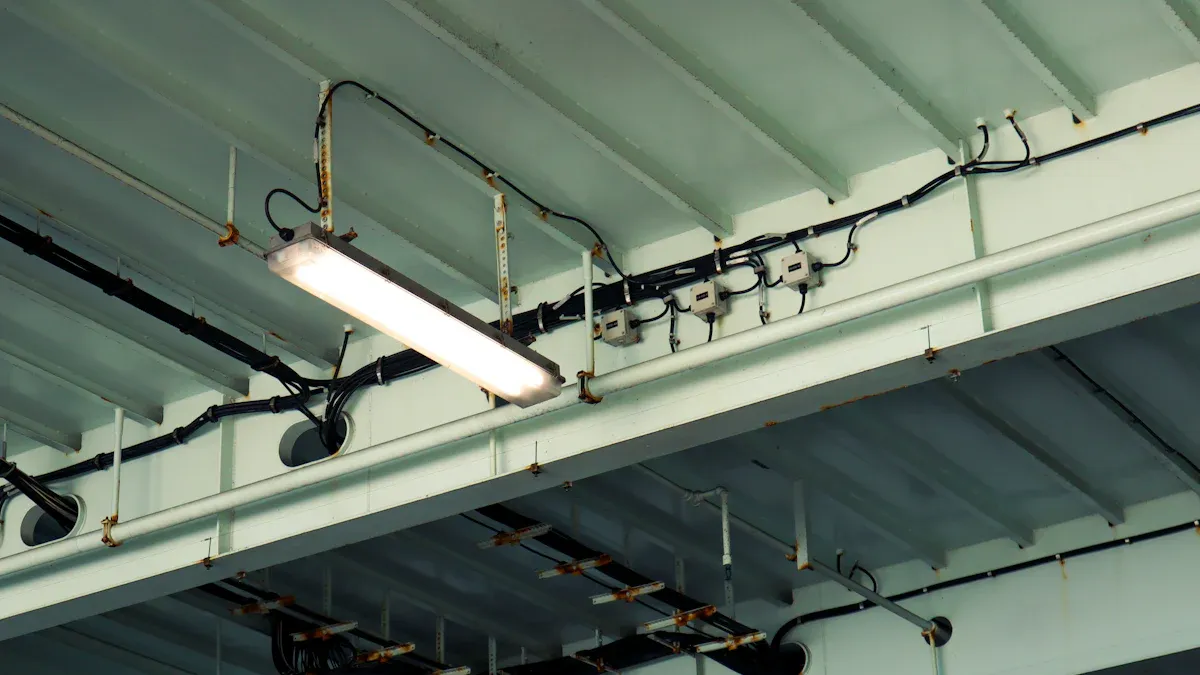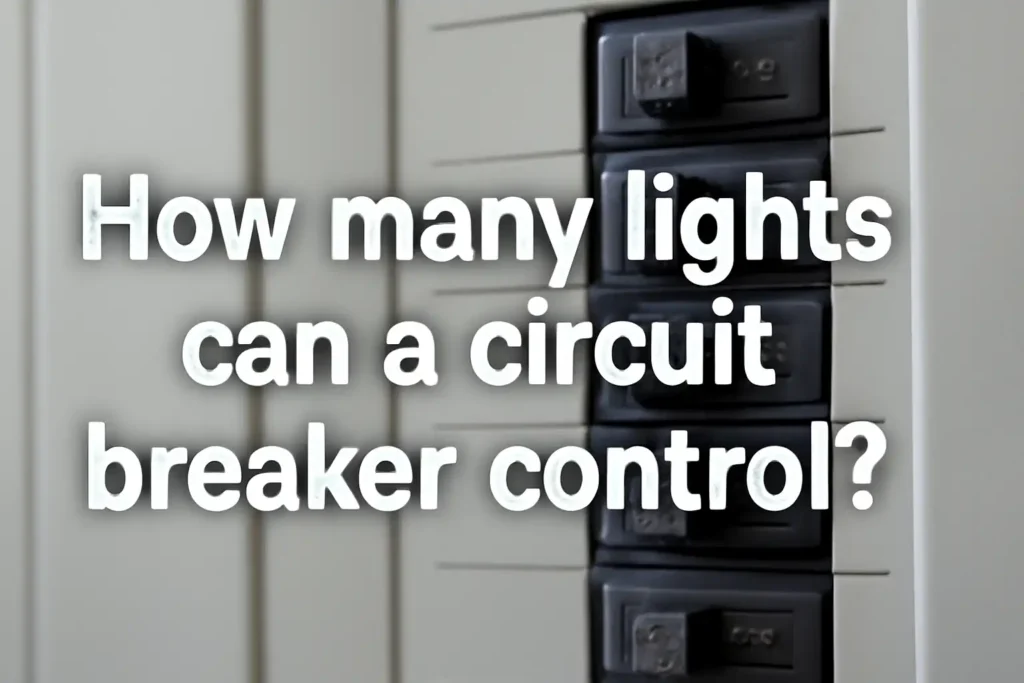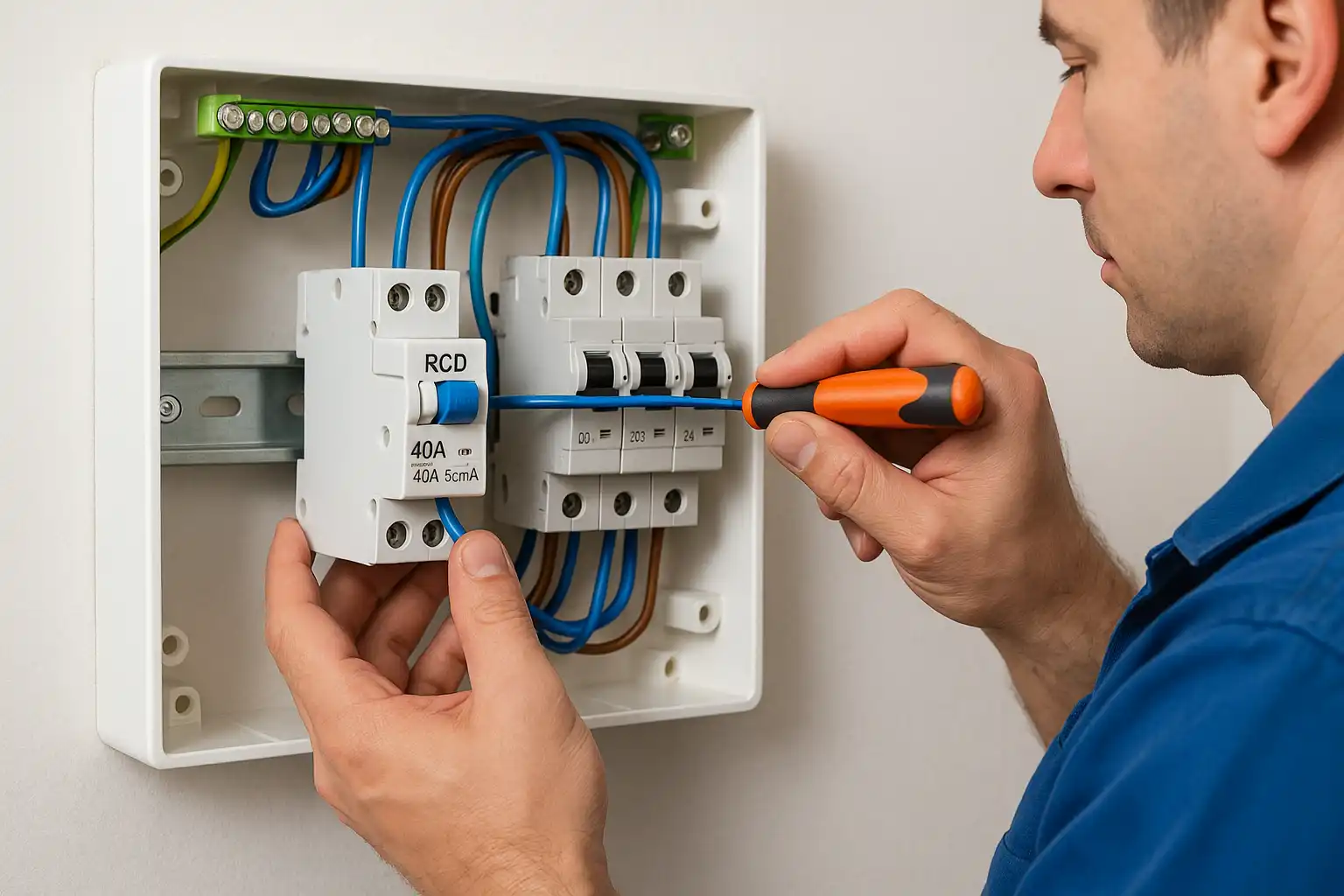You might ask how many lights one circuit breaker control can handle safely. A 15-amp breaker at 120 volts supports up to 1800 watts. The number of lights depends on their power use. For example:
- Lights using 60 watts each allow up to 30 lights.
- Lights using 100 watts each lower the limit to 18.
- Lights using 150 watts each limit you to 12.
Knowing these limits helps prevent overloading your circuit breaker control. This keeps things safe and follows electrical rules.
Key Takeaways
- A 15-amp breaker can handle up to 1,440 watts safely.
- LED lights use less power, so you can add more lights.
- Follow the 80% rule: keep wattage below 80% of the breaker’s limit.
- Watch for flickering lights or warm outlets as warning signs.
- Ask an electrician for help with breaker limits and safety tips.
Key Factors in Circuit Breaker Control
Knowing what affects circuit breaker control helps keep your home’s electricity safe. These factors decide how many lights can be connected without causing problems. Let’s break them down.
Wattage of Light Fixtures
The power use of light fixtures affects the load on the circuit breaker. Fixtures using more watts need more power, so fewer lights can be added. To figure out the load, use this formula:
Amps = Watts ÷ Volts
For example, a 200-watt light on a 120-volt circuit uses about 1.67 amps. A 15-amp breaker can handle up to 9 of these lights while staying under the safe limit of 12 amps (80% of capacity). Lights with lower wattage, like LEDs, let you add more because they use less power.
Tip: Using LED lights lowers the load on your circuit breaker. This lets you safely connect more lights.
Circuit Breaker Amp Rating (15-amp vs. 20-amp)
The amp rating shows how much power a circuit breaker can handle. A 15-amp breaker supports up to 15 amps, and a 20-amp breaker handles up to 20 amps. For safety, only use 80% of this capacity:
- A 15-amp breaker allows 12 usable amps.
- A 20-amp breaker provides 16 usable amps.
Here’s how these ratings work for lighting:
| Breaker Rating | Usable Amps (80%) | Max Wattage (120V Circuit) |
|---|---|---|
| 15 amps | 12 amps | 1,440 watts |
| 20 amps | 16 amps | 1,920 watts |
A 20-amp breaker is better for circuits with bigger loads or larger lights. But the breaker must match your home’s wiring. Using a breaker that’s too strong for the wiring can cause fires.
Voltage of the Circuit (120V vs. 240V)
The voltage decides how much power a circuit can give. Most homes in the U.S. use 120 volts, but some circuits use 240 volts for bigger loads. Higher voltage circuits deliver more power for the same amps. For example:
- A 120-volt circuit with a 15-amp breaker supports 1,800 watts (1,440 watts at 80%).
- A 240-volt circuit with a 15-amp breaker supports 3,600 watts (2,880 watts at 80%).
240-volt circuits are good for heavy appliances or large lighting setups. But most regular lighting circuits use 120 volts. Always check your circuit’s voltage before figuring out its capacity.
Note: 240-volt circuits handle more power but need special wiring. They’re not usually used for regular lighting.
By knowing about wattage, amp ratings, and voltage, you can make smart choices for your circuit breaker control. This keeps your electrical system safe and working well.
Calculating the Number of Lights Safely

Understanding the 80% Rule for Circuit Load
To know how many lights a circuit can handle, use the 80% rule. This rule keeps the circuit from overheating or tripping. Follow these steps to apply it:
- Find the circuit’s total capacity: Multiply the breaker’s amps by the voltage. For example, a 15-amp breaker on a 120-volt circuit gives 1,800 watts (15 × 120 = 1,800 watts).
- Use the 80% rule: Multiply the total capacity by 0.8 to get the safe limit. In this case, 1,800 watts × 0.8 = 1,440 watts.
- Add up your lights’ wattage: Combine the wattage of all the lights you want to connect. Make sure the total stays under the safe limit.
- Check the needed amperage: Divide the total wattage by the circuit voltage. For example, if your lights use 1,200 watts on a 120-volt circuit, the load is 10 amps (1,200 ÷ 120 = 10 amps).
Tip: Leave extra room for future devices or upgrades. Staying below 80% keeps your circuit breaker control safe and efficient.
Example Calculation for Different Light Types
Here’s an example to show how to calculate the number of lights for different wattages. This example uses a 15-amp breaker on a 120-volt circuit:
| Step | Description | Calculation | Result |
|---|---|---|---|
| 1 | Total circuit capacity | 15 amps × 120 volts | 1,800 watts |
| 2 | Safe load limit (80% rule) | 1,800 watts × 0.8 | 1,440 watts |
| 3 | Number of 60-watt bulbs allowed | 1,440 watts ÷ 60 watts | 24 bulbs |
| 4 | Number of 100-watt bulbs allowed | 1,440 watts ÷ 100 watts | 14 bulbs |
| 5 | Number of 150-watt bulbs allowed | 1,440 watts ÷ 150 watts | 9 bulbs |
This table shows how bulb wattage affects the number of lights you can connect. Lower-wattage bulbs, like LEDs, let you add more lights without overloading the circuit.
Note: Always check your calculations with local electrical codes. These codes ensure your wiring and circuit breaker control are safe.
By using these steps and examples, you can figure out how many lights your circuit can handle. This helps avoid overloads and keeps your electrical system safe and reliable.
Safety Tips for Circuit Breaker Use
Why Following Electrical Rules Matters
Electrical rules keep your home safe from dangers. They make sure your circuit breaker works well and avoids problems. Following these rules lowers the chance of fires, broken equipment, or injuries. For example, the National Electrical Code (NEC) has clear rules for setting up and caring for circuit breakers.
| Rule Section | What It Requires |
|---|---|
| Section 250.4(A)(5) | Says electrical gear must create a low-resistance path for safety devices to work properly. |
| Section 250.122(B) | Requires bigger grounding wires when voltage drops and ungrounded wires increase. |
Following these rules helps your system handle power safely. Ignoring them can cause overheating or short circuits. Always ask a licensed electrician to check local rules before changing your circuit breaker.
Spotting and Avoiding Overloaded Circuits
Circuits get overloaded when they use more power than they can handle. This can make breakers trip or even cause fires. Knowing the signs of overload is important. Flickering lights, breakers tripping often, and warm outlets are common clues.
To stop overloads, add up the wattage of all devices and lights on a circuit. Keep the total under 80% of the breaker’s limit. Regular check-ups also help prevent problems. Testing your gear and checking wires can catch issues early.
| Safety Step | Why It’s Important |
|---|---|
| Remote Operation | Lets electricians control breakers from far away, avoiding injury during dangerous events like arc flashes. |
| Maintenance Checks | Regular tests and fixes stop failures that could lead to unsafe situations, like arc flashes. |
| Arc Flash Reviews | NFPA 70E requires updates to arc flash safety plans to keep electricians safe with proper gear. |
By staying alert, you can avoid overloaded circuits. This keeps your home safe and makes your electrical system last longer.
Practical Tips for Managing Circuit Breaker Control
Using LED Lights to Lower the Load
Switching to LED lights is a simple way to reduce the load on your circuit breaker. LEDs use much less power than older incandescent or fluorescent bulbs. For example:
- LEDs give 80-100 lumens per watt, while incandescent bulbs only give 10-15.
- They produce very little heat, wasting less energy.
- LEDs last for thousands of hours, so you replace them less often.
Using LEDs lets you add more lights to one circuit without overloading it. This is helpful for homes with older wiring or small circuit breaker capacity. LEDs also use steady power, unlike other bulbs that need extra energy to start. This steady use protects your circuit breaker, making it last longer and lowering repair costs.
Tip: Replacing high-power bulbs with LEDs saves energy and helps manage your circuit breaker better.
When to Replace Your Circuit Breaker
You might need to replace your circuit breaker if it can’t handle your home’s power needs. Over time, wear and tear can make it less effective. This can cause frequent tripping or even failure. If you see flickering lights, warm outlets, or can’t add new devices without tripping the breaker, it may be time for a replacement.
The life of a circuit breaker depends on how much wear it has. When it wears out too much, it stops working well. Knowing how long your breaker will last helps you plan for a replacement before it fails. You might also need a stronger breaker if you’re adding new appliances or more lights.
Note: Always ask a licensed electrician before replacing your circuit breaker to make sure it works with your home’s wiring.
A 15-amp breaker can usually handle 8-10 lights. The exact number depends on each light’s wattage and total power use. Using the 80% rule keeps the breaker safe from overheating or tripping. The National Electric Code (NEC) suggests one 15-amp circuit for every 800 square feet. This shows a single circuit can safely support many lights. If you’re unsure, ask a licensed electrician for advice. They ensure your setup follows rules and keeps your home safe.
FAQ
Why is the 80% rule important for circuit breakers?
The 80% rule keeps your circuit breaker safe and working well. It stops overloading by keeping the load below its full capacity. This helps avoid overheating, tripping, or other dangers in your home.
Why pick LED lights over incandescent bulbs?
LED lights use less power and stay cooler than incandescent bulbs. This means you can add more lights to one circuit safely. LEDs also last longer, saving money on energy and replacements.
Why do circuit breakers trip when overloaded?
Breakers trip to stop wires from getting too hot. Overloads happen when too much power is used on a circuit. Tripping cuts the power to prevent fires or damage to your system.
Why match the breaker to your home’s wiring?
A breaker that doesn’t fit your wiring can overheat or cause fires. The breaker’s amps must match the wire size for safety. Always ask an electrician to check before making changes.
Why call an electrician for circuit breaker problems?
Electricians know safety rules and how to fix electrical issues. They can check your system, find problems, and suggest safe fixes. Hiring an expert ensures your breaker works well and follows local rules.
The following information may be of interest to you
How to choose the appropriate size of circuit breaker
How to Accurately Calculate Electricity Load for Your Household
How many watts can a 20 ampere circuit breaker handle
How many watts of power a 15 ampere circuit breaker can withstand





